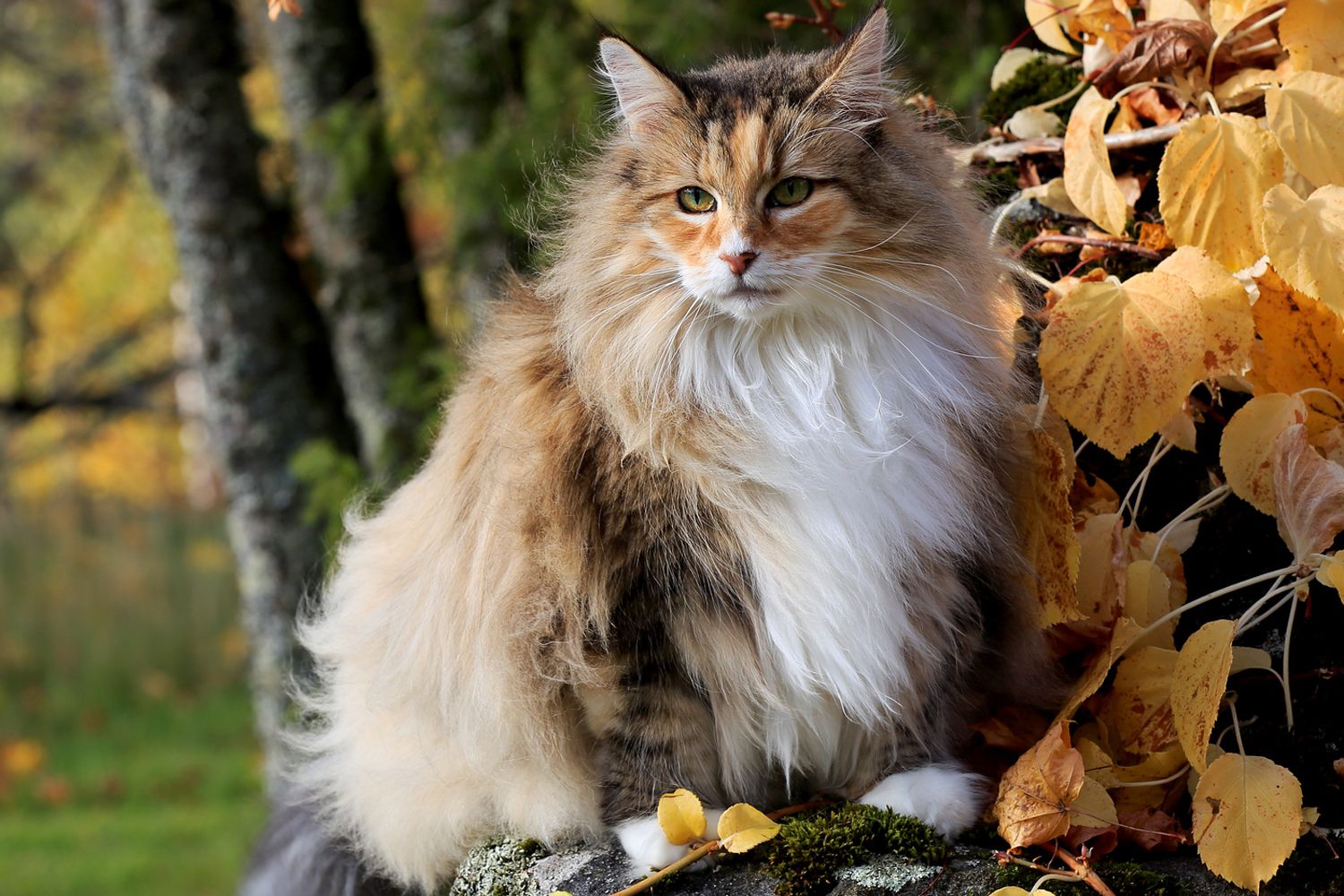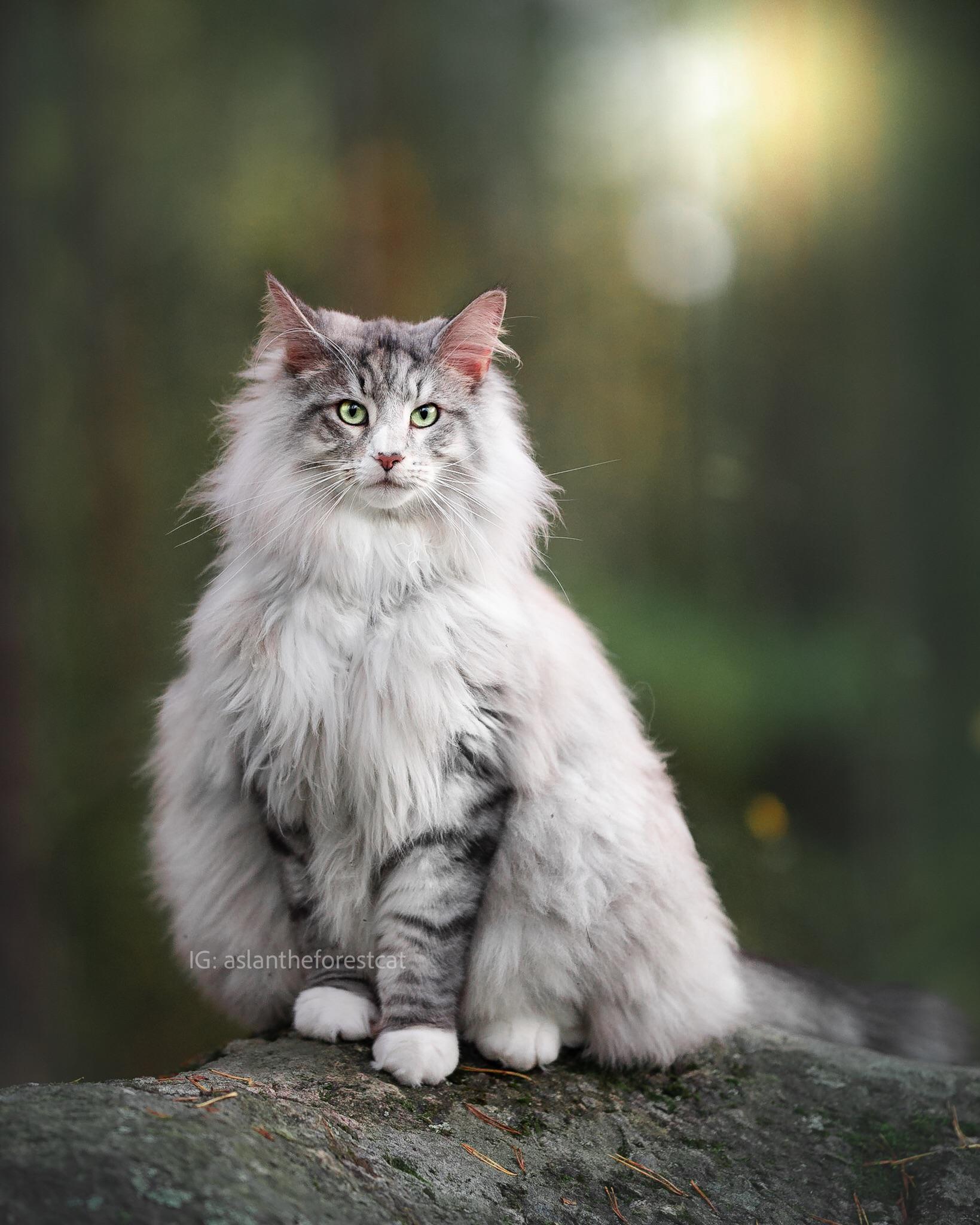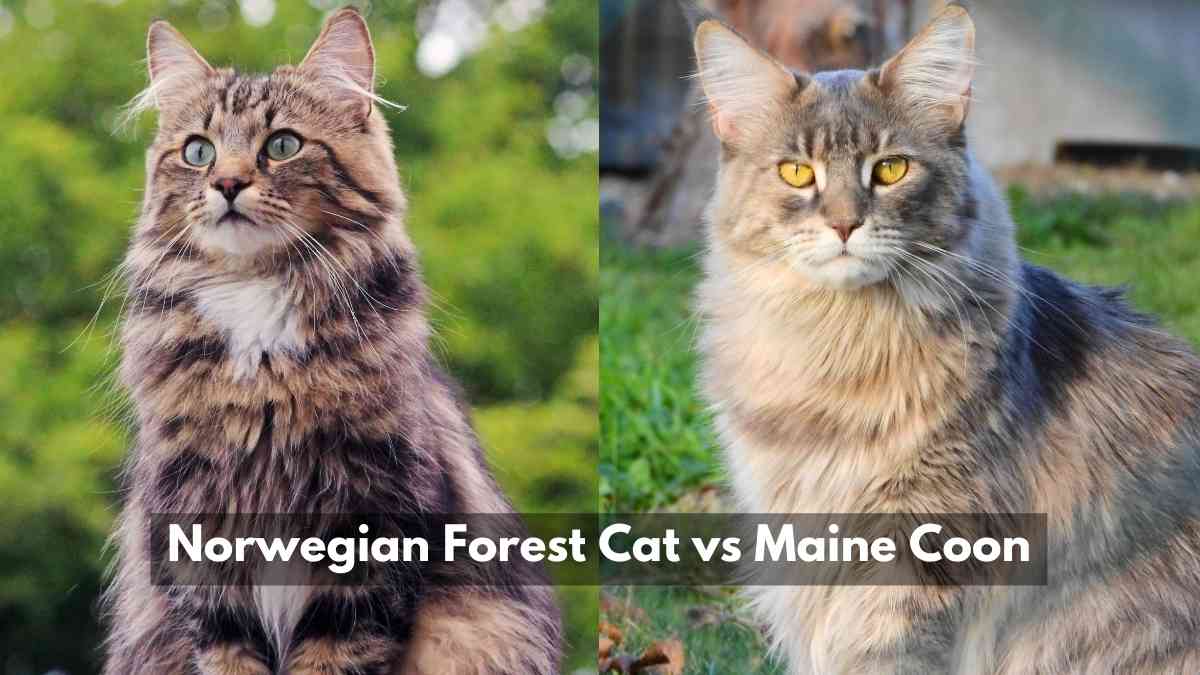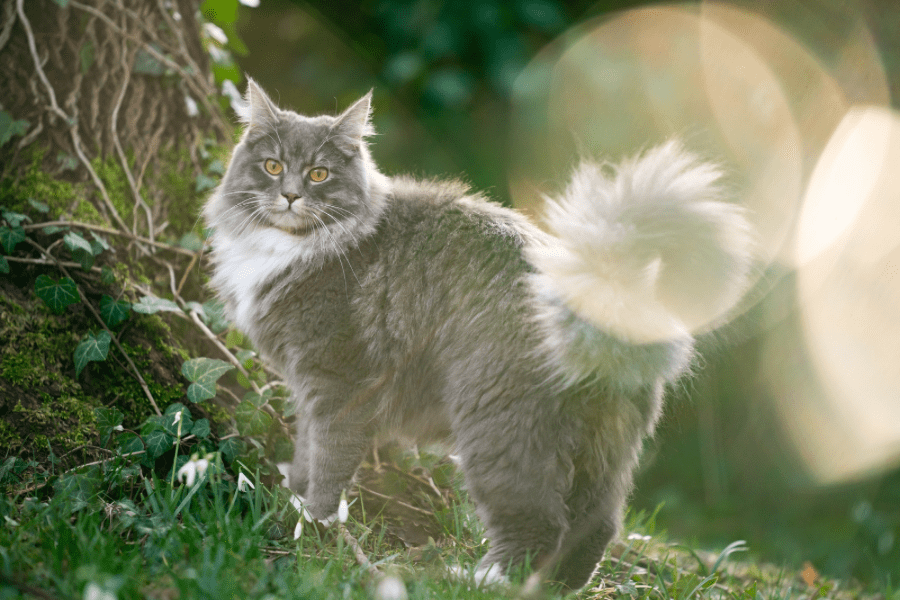To care for a Norwegian Forest Cat, provide regular grooming and create a stimulating environment. Ensure a balanced diet and schedule routine vet checkups.
Norwegian Forest Cats, with their luxurious double coats and sturdy builds, are a sight to beckon cat enthusiasts. Their lineage, steeped in Viking lore, bespeaks of their adaptability and vigor. Captivating feline lovers, Norwegian Forest Cats require attention to their unique needs to stay healthy and content.
Their thick fur demands frequent brushing to prevent mats and reduce shedding, while their active nature craves interactive playtime and climbing opportunities. As a responsible owner, integrating a well-rounded diet and consistent veterinary care is paramount in maintaining this breed’s robust health. Adopting a Norwegian Forest Cat introduces you to a companion whose majestic presence and engaging personality enrich your life, provided their care is as magnificent as their heritage.
Meet The Norwegian Forest Cat
Ready to leap into the world of majestic felines? Welcome to the realm of the Norwegian Forest Cat, a breed renowned for its luxurious fur and mystical history. These cats are not just pets; they’re a blend of nature’s finest work with a fairy tale-like essence. Let’s discover the wonders of this breed together!
Origins And History
Norwegian Forest Cats boast a rich and storied past. Known as ‘Skogkatt’ in their homeland, these felines have been companions to the Vikings and inspiration to Norse myths. Legends speak of their prowess and strength, navigating the rugged landscapes of Norway with ease.
- Country of origin: Norway
- Historical role: Mouser on Viking ships
- Norse mythology: Sacred to goddess Freya
This breed’s journey from wilderness to home is nothing short of magical. The Norwegian Forest Cat is not just a breed; it’s a piece of history curled up on your lap.
Physical Characteristics
The Norwegian Forest Cat is a marvel of feline genetics, equipped for the harsh Scandinavian winters. Let’s highlight their physical attributes in a table:
| Characteristic | Description |
|---|---|
| Size | Large and muscular |
| Weight | Up to 22 pounds (Males), Slightly less (Females) |
| Coat | Thick double layer, water-resistant |
| Colors | Variety; from whites to blacks and tabbies |
| Eyes | Almond shape, range of colors |
| Life span | 12-16 years typically |
| Temperament | Playful, loyal, and friendly |
With tufted ears, a bushy tail, and a sturdy build, the Norwegian Forest Cat walks with a royal grace. These felines are built to survive and thrive.
Creating A Safe And Welcoming Environment
Creating a safe and welcoming environment for your Norwegian Forest Cat is essential. These majestic felines thrive in spaces that satisfy their curiosity and need for adventure. Catering to both their indoor and outdoor instincts is key to their well-being.
Indoor Space Requirements
Understanding your Norwegian Forest Cat’s indoor habitat is crucial. These cats are known for their size and activity levels. They require ample room to climb, play, and explore. Ensure your space meets their needs with these tips:
- Cat trees and perches: Provide multiple levels for climbing and surveying their domain.
- Scratching posts: Keep their claws healthy and your furniture safe with sturdy options.
- Interactive toys: Stimulate their hunter instincts with puzzles and teasers.
- Resting areas: Cozy nooks and beds for napping promote relaxation.
Outdoor Exploration
While Norwegian Forest Cats love being indoors, they also have a deep desire for outdoor exploration. Here’s how to satisfy their wanderlust safely:
- Enclosed spaces: A catio or secured yard allows for risk-free exploration.
- Leash training: Harness the fun with supervised walks.
- Regular checks: Ensure all exits are secure to prevent accidental escapes.
- Identification: A microchip and collar with ID tags keep them safe.
By integrating these elements into your home, you’ll create an environment where your Norwegian Forest Cat can flourish both indoors and out.
Nutritional Needs And Feeding
The Norwegian Forest Cat, with its lush coat and robust build, requires a diet that will keep its fur shiny and body healthy. This section will explore the optimal diet for maintaining your feline friend’s vitality.
Dietary Considerations
Norwegian Forest Cats need balanced nutrition. This includes a mix of protein, fats, and carbohydrates. Their diet should mirror what they would eat in the wild.
- High-quality animal protein – crucial for muscle development and energy levels.
- Fatty acids like omega-3 and omega-6 – these keep their coat glossy and healthy.
- Avoid fillers like corn and grains – these can lead to obesity and do not provide the necessary nutrients.
| Component | Benefit |
|---|---|
| Protein | Builds muscle and provides energy |
| Fatty Acids | Enhances coat sheen and supports skin health |
| Taurine | Essential for heart and eye health |
Feeding Schedule And Portions
Consistency is key for feeding your Norwegian Forest Cat. Establishing a routine helps manage their weight and supports digestive health.
- Feed twice a day – once in the morning and once in the evening.
- Measure portions based on age and activity levels – kittens and active adults need more calories.
- Consult your vet for the best portion sizes for your cat’s needs.
- Check the food’s label for portion guidelines.
- Adjust portions as your cat grows and changes.
- Keep fresh water available at all times.
Maintaining Health And Vigor
Keeping your Norwegian Forest Cat healthy and vibrant requires attention to their unique needs. These majestic felines come with a set of care guidelines to ensure they live a happy, active life.
Routine Veterinary Visits
Regular check-ups are crucial for any pet, especially the robust Norwegian Forest Cat. Scheduling annual visits to the vet will help keep your cat in prime condition. These visits typically include:
- Vaccinations to prevent common diseases
- Parasite control for internal and external pests
- Dental check-ups to avoid tooth and gum problems
- General health assessments that monitor weight and vital signs
Additional visits may become necessary if your cat shows signs of illness or discomfort.
Common Health Issues
Norwegian Forest Cats are generally healthy, but like all breeds, they can face certain health challenges. Awareness is key. Be mindful of:
| Health Issue | Signs to Watch For |
|---|---|
| Hip Dysplasia | Limping, difficulty jumping |
| Heart Diseases | Coughing, breathing problems |
| Kidney Diseases | Increased thirst, weight loss |
Immediate vet care can help manage these issues if they arise. A nutritious diet, regular exercise, and clean living environments also mitigate risks.
Grooming Essentials
Grooming your Norwegian Forest Cat not only keeps them looking majestic but also promotes good health. These cats have thick, luxurious coats that require regular attention. Explore the essentials of proper grooming, from coat care to nail trimming.
Coat Care Techniques
Due to their double-layered coat, Norwegian Forest Cats require thorough grooming. Brushing should happen several times a week. This routine prevents knots and reduces shedding. During shedding seasons, such as spring and fall, increase brushing frequency to manage the extra loose fur.
Brushing Tips:
- Long-toothed combs reach the undercoat.
- Slicker brushes help remove tangles.
- Stainless steel scissors may be used to carefully cut out mats.
Mat Prevention:
- Start at the head and work your way down.
- Be gentle around sensitive areas.
- Groom regularly to avoid mat formation.
Bathing And Nail Trimming
Norwegian Forest Cats rarely need baths, but it’s good to know how. Use a cat-specific shampoo and ensure the water is warm, not hot. Always rinse thoroughly, as soap residue can irritate their skin. After bathing, dry them well, especially in cooler climates.
Bathing Steps:
- Wet the coat thoroughly.
- Apply shampoo gently.
- Rinse until water runs clear.
Nail trimming should be a calm, stress-free experience. Use sharp, cat-specific clippers. Clip only the tips to avoid the quick where nerves and blood vessels are. It’s a good idea to have styptic powder nearby in case you cut too far.
Nail Care Quick Guide:
- Trim nails every few weeks.
- Hold the paw firmly but gently.
- Clip the tip, avoid the quick.

Credit: www.wikihow.com
Exercise And Playtime
Norwegian Forest Cats thrive on physical activity. These energetic creatures need regular exercise to maintain their health and happiness. Engaging playtime is essential for their physical and mental well-being. A balance of intriguing toys and outdoor escapades will keep your furry friend in top shape.
Interactive Toys and ActivitiesInteractive Toys And Activities
Keep your cat active with stimulating toys. Variety is key in preventing boredom.
Interactive toys are a great way to mimic hunting behaviors. Laser pointers, feather wands, and puzzle feeders engage their instincts. Cats love chasing and pouncing. It keeps them agile.
- Laser pointers: Creates a mock-chase game
- Feather wands: Simulates flying prey
- Puzzle feeders: Offers mental stimulation
Outdoor Adventures
Supervised outdoor time can enrich your Norwegian Forest Cat’s life. These cats have a natural love for climbing and exploration.
A secured backyard or leash walks allows safe exploration. Remember to keep vaccinations and flea treatment up-to-date for outdoor trips.
- Insulated outdoor cat house
- Cat-proof fence Adjustable cat harness for walks
Fostering Social Interaction
Fostering social interactions is crucial for the well-being of your Norwegian Forest Cat. Norwegian Forest Cats, known for their friendly nature, flourish in environments where they can connect with humans and other pets. Encouraging these interactions helps nurture their social skills and keeps them mentally stimulated.
Socializing With Humans
Integrating your Norwegian Forest Cat into your family involves gentle handling and playtime. Establish a routine for your cat to interact with all household members. Use the following tips:
- Regular Playtime: Dedicate time each day for play. This builds trust and a strong bond.
- Gentle Handling: Teach everyone to handle your cat with care. This prevents any fear of humans.
- Positive Reinforcement: Use treats and praises to encourage interaction. This makes socializing a pleasurable experience.
Introducing To Other Pets
Introducing your Norwegian Forest Cat to other pets requires patience. Start with small, supervised interactions. Follow these steps:
- Create a Safe Space: Give your cat a safe place away from other pets at first.
- Supervised Meetings: Keep initial encounters short and under control.
- Separate Resources: Ensure each pet has their own food, water, and litter box.
- Gradual Introduction: Over time, allow your cat more freedom to interact.

Credit: www.wikihow.com
Understanding Their Unique Traits
Knowing the special ways of a Norwegian Forest Cat is key to their care. These cats shine with their one-of-a-kind personality and ways they ‘speak’. Let’s dive into what makes them unique!
Personality And Temperament
Norwegian Forest Cats radiate a calm aura yet possess a playful spirit. This majestic breed shows immense love for their families. Known for their easy-going nature, they adapt well to different homes. Independent but affectionate, these cats bond with their humans without being overly needy.
While dignified, they enjoy a good game, often showcasing their strong hunting instincts. Your furry friend might surprise you with how cleverly they can navigate their environment, thanks to their agile bodies and sharp minds.
Vocalization And Communication
Contrary to many cat stereotypes, the Norwegian Forest Cat isn’t a chatterbox but has unique ways of communicating. They will often speak through soft chirps and gentle mews to express themselves.
Their vocalizations seem to tell stories of their escapades or call for attention. Understanding these calls can help you respond to their needs, creating a stronger bond. Watch their body language too—it’s a big part of how they talk!
- Chirps and trills – May signal a desire to play or show affection.
- Mews – Can be a greeting or a request for something, like food or cuddles.
- Purring – Often means your cat is content and feels safe.
- Ear and tail positions – Offer clues to their mood and intentions.
Credit: www.quora.com
Frequently Asked Questions For How To Take Care Of A Norwegian Forest Cat
Are Norwegian Forest Cats Easy To Take Care Of?
Norwegian Forest cats are generally low-maintenance. Their thick coat needs weekly brushing, and they adapt well to indoor or outdoor environments. Regular vet checkups ensure their health.
Can Norwegian Forest Cats Be Left Alone?
Norwegian Forest cats value companionship but can tolerate solitude. Provide ample toys and engagement if left alone regularly. Extended isolation may affect their well-being.
Do Norwegian Forest Cats Cuddle?
Norwegian Forest cats are affectionate and enjoy cuddling with their human companions. Their friendly nature makes them loving pets that seek out warmth and affection.
Can You Keep A Norwegian Forest Cat Indoors?
Yes, you can keep a Norwegian Forest cat indoors. Provide ample space, stimulating toys, and regular interaction to maintain their health and happiness. Ensure they have access to a scratching post and high perches for exercise and entertainment. Regular grooming is also essential for their thick fur.
Conclusion
Caring for a Norwegian Forest Cat brings joy and companionship to any home. Remember, regular grooming, a balanced diet, and plenty of play keep this majestic breed healthy and happy. Embrace these tips and watch your furry friend thrive in the comfort of your love and care.



